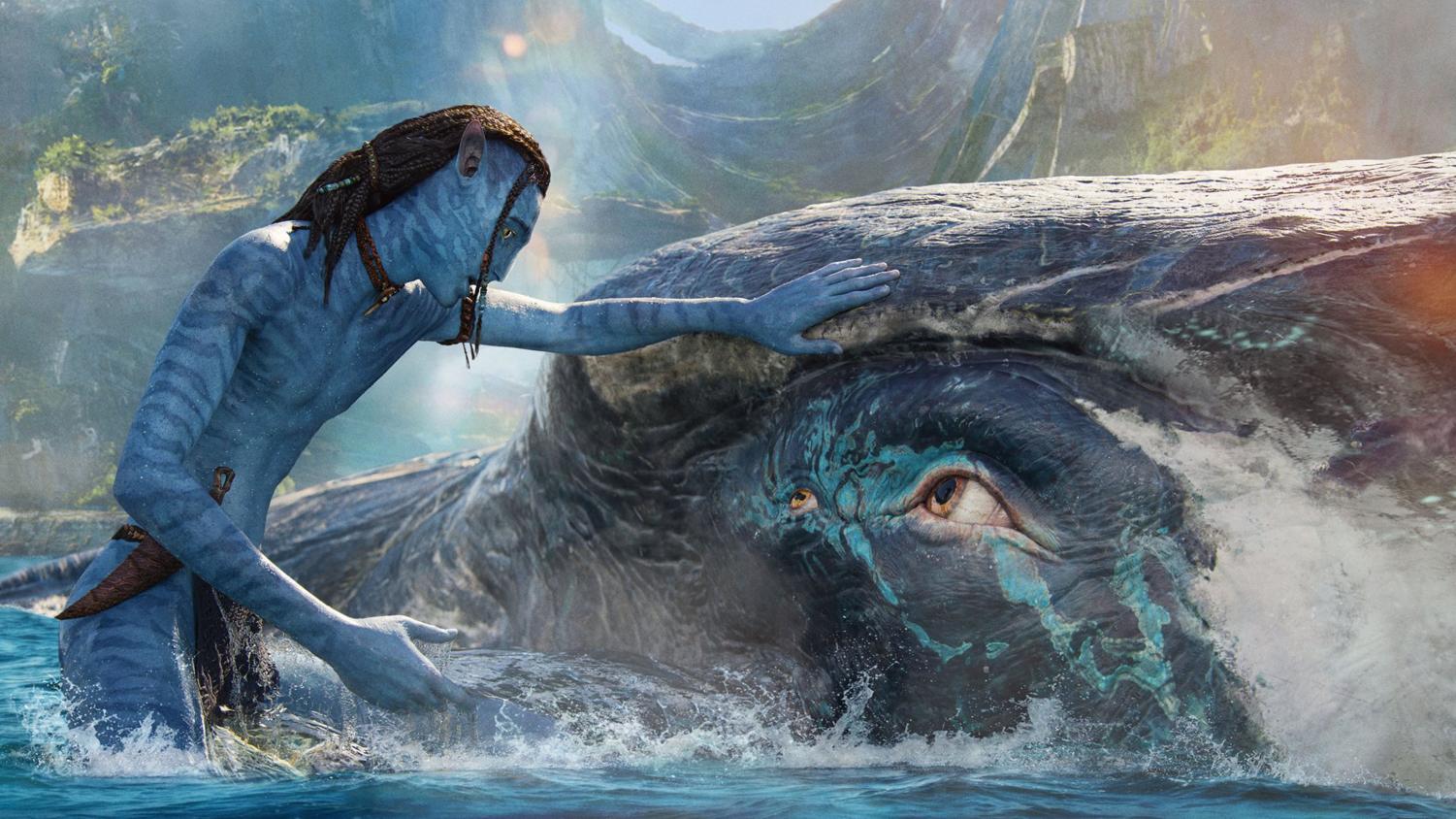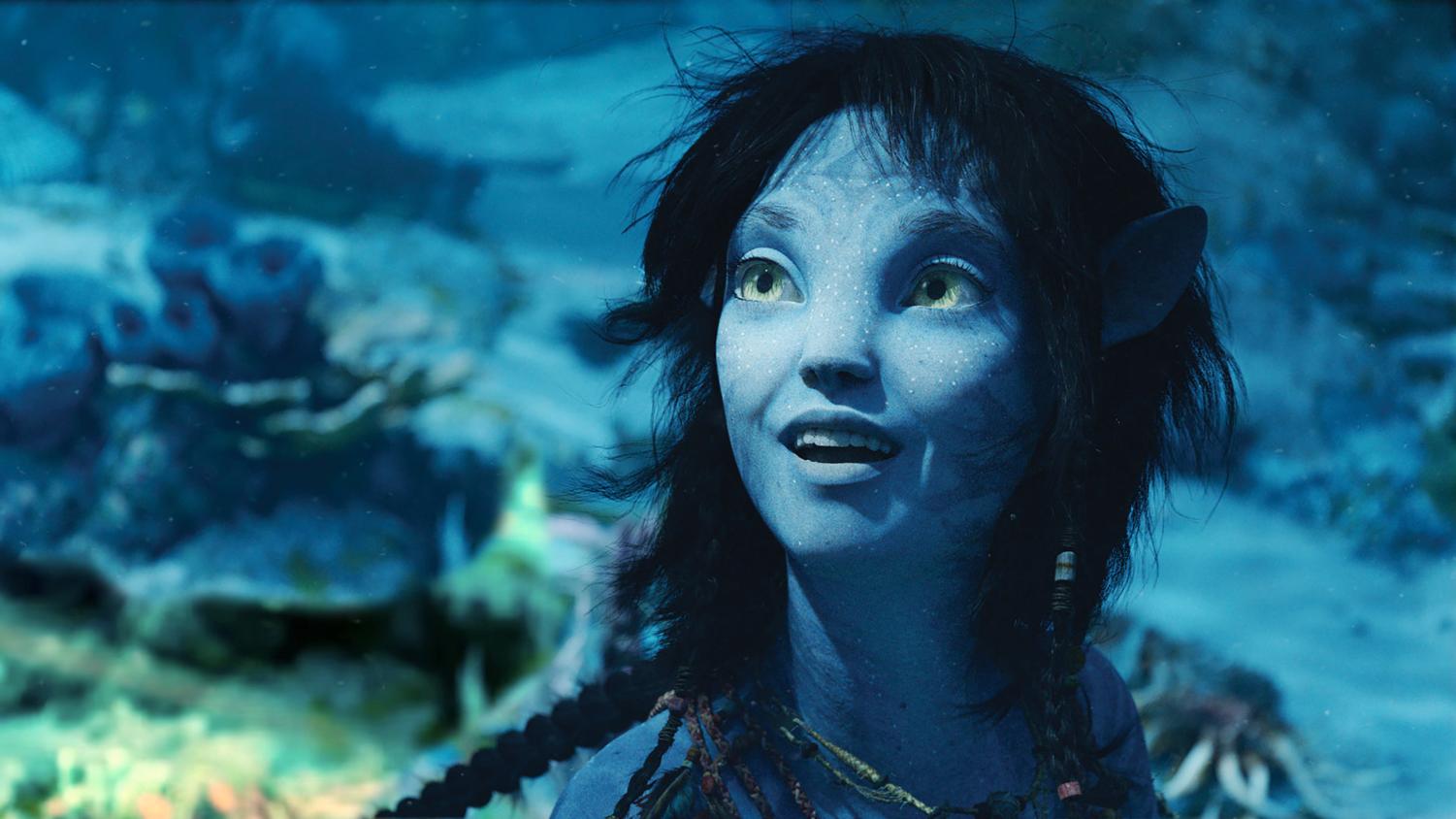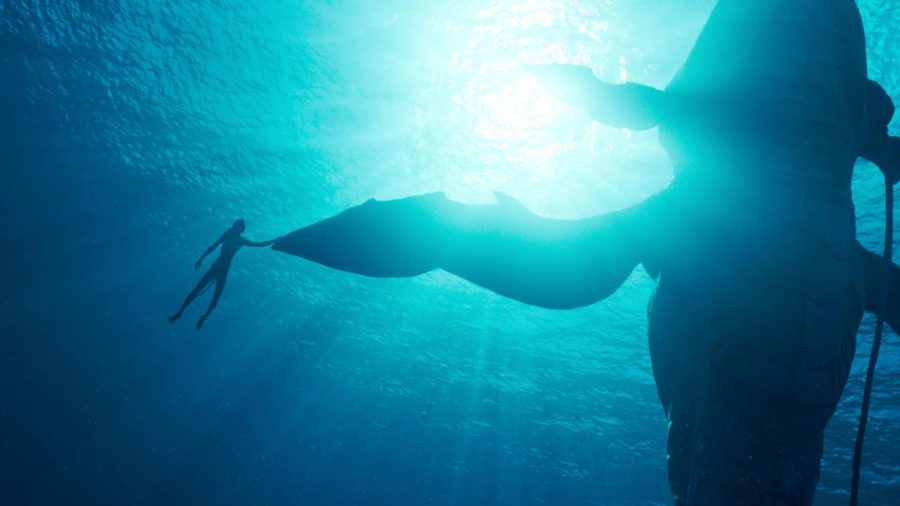“Avatar: The Way of Water:” a monumental achievement of blockbuster filmmaking
Never doubt James Cameron, because his follow-up to the highest grossing film of all time tops it as easily the greatest blockbuster of the century so far.
December 21, 2022
“Everything is backwards now, like out there is the true world, and in here is the dream.”
So said Jake Sully in one of many great audience surrogate moments in “Avatar,” a film that infamously may or may not have caused genuine cases of clinical depression and even suicidal thoughts in the fans who were as engrossed in the natural planet of Pandora as its protagonist was and couldn’t bear to return to normal reality after experiencing the film—but really, who could blame them? The massive world that James Cameron created and the seemingly endless stream of images and ideas he used to translate it to the screen resulted in one of the few truly visionary pieces of blockbuster cinema, and now, he’s (finally) back with “The Way of Water.” After thirteen years and an insufferable amount of online discourse about how its predecessor never had any cultural footprint—as if grossing a total of nearly $3 billion at the worldwide box office as well as over $75 million in a one week re-release only a couple of months prior to the sequel isn’t clear enough of an answer to haters—there was an equal mix of anticipation and pressure riding on this film. But time is indeed a flat circle, and the same essential truth seen in the previous successes of “Titanic” and the first “Avatar” has never been more essential or true. Never, ever doubt James Cameron, because “Avatar: The Way of Water” is absolutely monumental filmmaking.
It’s been over ten years since the events of the first film, and a lot has changed for Jarhead-turned-Omaticaya clan leader Jake Sully (played by Sam Worthington) and his wife Neytiri (played by Zoe Saldana). The two are raising a family—comprised of their biological children Neteyam (played by James Flatters), Lo’ak (played by Britain Dalton) and Tuktirey (or Tuk; played by Trinity Jo-Li Bliss), as well as their adopted teenage daughter who was inexplicably, preternaturally birthed from the unconscious avatar of Dr. Grace Augustine (played by Sigourney Weaver), Kiri (played by… Sigourney Weaver) and the human boy who tags alongside the kids, Spider (played by Jack Champion)—but are forced to resume their roles as the commanders and warriors of the guerilla movement against the “sky people” who have returned and are attempting to colonize Pandora along with a vengeful Col. Miles Quaritch (played by Stephen Lang) whose memories and personality have been resurrected in what’s called a recombinant avatar. As the leader of the insurgency, the target on Jake’s head makes his presence among the Omaticaya people a threat to the entire tribe, so the Sully’s abandon their home in the forest and travel to the reef clan of the Metkayina led by Tonowari (played by Cliff Curtis) and his wife Ronal (played by Kate Winslet) and start to adapt to their way of life, but it’s not long before the war catches up with them yet again.
The opening forty-five minutes of “The Way of Water” serve as a breakneck recap and exposition dump so breathless that it’ll likely exhaust anyone who doesn’t fully and/or fondly remember the story beats of the first film, but as a return to the world of Pandora, it’s as sweeping as ever, and the second it reaches the ocean, that feeling is amplified tenfold. The entire second act of this film is virtually plotless as it lets the audience luxuriate in the new aquatic environment while also introducing them to its many characters and creatures and cross cutting between the Sully family and the encroaching military recombinants, and the structure very well could have fallen apart if it weren’t for how committed James Cameron and his cast and crew clearly are to every single detail that permeates every frame, no matter how minor. Mecha exoskeleton-sized coffee mugs, Na’vi-sized pairs of Oakley sunglasses and giant whales called tulkun that share spiritual bonds with the Metkayina people and are capable of understanding philosophy, mathematics, music and complex language—all of these aspects of this world that would likely be made into immature jokes in the hands of a lesser filmmaker are delivered with such genuine sincerity that they don’t even immediately register as absurd for the viewer.

It also helps, of course, that they’re portrayed through an estimated budget of $350-460 million dollars that was spent over thirteen long years, and for once in a film with a major release, you can see all of the money and effort on the screen. On a purely technical level, there’s really no argument to be made against “The Way of Water” as the greatest visual effects ever created in the realm of cinema. Seeing the film in IMAX 3D, I eventually reached a point where I simply gave up trying to comprehend that none of what I was seeing—every bioluminescent flourish, strand of hair, grain of sand and (obviously) bead of water—was actually real. As if the first film’s visuals aren’t still unparalleled over a decade later, this is an even grander showcase of the utterly seamless technological wizardry and creative innovation that Cameron and his team are willing to push the boundaries of, from the extensive freediving performed by the actors, the underwater motion capture technology that recorded it and the unique sign language that the Na’vi use to communicate with each other and the tulkun. It’ll certainly be interesting to see what or if any major releases in the next couple of years will even attempt to reach the bar that this has set, because no film before this has and probably none after it—well, maybe except for the other “Avatar” sequels—will reach this level of photorealism.
On a dramatic level as well, “The Way of Water” is a vast improvement over its already understated predecessor. Cameron’s writing abilities are as blunt as ever, but the leaden stretches of exposition and moralization are elevated by the cast. Sam Worthington and Zoe Saldana portray the maturations of Jake and Neytiri—how they have to manage being both leaders of the Na’vi and parents to their own kids and how their roles affect their family dynamic—effortlessly, and all of the child actors do an equally stellar job, but to talk about the new additions and changes of this film is to talk about Kiri. On paper, nothing about Kiri should really work; every aspect of her character—the candid introduction of her mind-boggling birth in the opening rush of expository narration and the fact that a 73-year-old Sigourney Weaver is playing her own fourteen-year-old alien daughter through motion capture—is just totally deranged, but if anyone could pull off a concept so wild, of course it would be James Cameron. Kiri is an incredible synthesis of the immaculately realized visual effects and a committed performance from Weaver, and her teenage angst and seemingly spiritual connection with nature and the Na’vi deity Eywa adds up to a character that’s as lovable as she is compelling. In a film full of bonafide miracles, she’s likely the greatest one.

That is, at least, until the final act. I won’t dare spoil anything, but the last hour of “The Way of Water” plays out in essentially one sustained action sequence that one-ups the spectacle, scope and gnarliness of the first film in every way imaginable—at its most climactic point, it’s jumping between three separate groups of characters all navigating and fighting their way around the battlefield, and the individual threads that are all given their payoff or are set in motion for the future sequels are plentiful in quality yet weave together so easily. In a career full of epic Third Acts, this might be Cameron’s greatest solely for how brutally he heightens the stakes—this is the first film I’ve seen in a long time where a character bleeding carries actual impact, and the masterful control he displays of choreography and the geography of the environment only builds the tension higher.
I know it’s never a great thing to deal out hyperbole, but I’d be lying if I said that “Avatar: The Way of Water” wasn’t one of the greatest major blockbusters I’ve ever seen and easily my favorite of the century thus far. After a while, this becomes less of a film and more of a vision of spiritual ecstasy, an airtight, colossal experience the likes of which have never been seen before in the medium and yet could only exist in it. This is what you go to the movies for, and I can’t wait to see where James Cameron takes this incredible franchise next and return to this world countless more times.
MASTERPIECE


